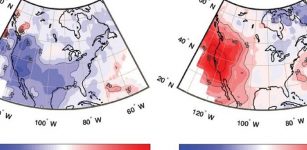Researchers Simulate 195 Million Years Of Global Climate In The Mesozoic
Eddie Gonzales Jr. – MessageToEagle.com – The Mesozoic, which stretched from about 252 million to 66 million years ago, was a pivotal period in Earth’s history.
In addition to being the age of the dinosaurs, it was when the supercontinent Pangaea began to separate into the fragmented continents we’re familiar with today. Together with elevated levels of carbon dioxide and the brightening Sun, tectonic changes influenced the global climate, producing warm and humid greenhouse conditions.
 During the Mesozoic, the fragmentation of Pangaea contributed to long-term climate trends, such as weaker seasonality and warmer global mean temperatures. Shown are paleogeographic reconstructions for (left to right) 250 million, 150 million, and 70 million years ago. Credit: Jan Landwehrs; data provided by Christopher Scotese
During the Mesozoic, the fragmentation of Pangaea contributed to long-term climate trends, such as weaker seasonality and warmer global mean temperatures. Shown are paleogeographic reconstructions for (left to right) 250 million, 150 million, and 70 million years ago. Credit: Jan Landwehrs; data provided by Christopher Scotese
A detailed understanding of the factors that drove Mesozoic climate trends will not only provide insight into Earth’s history but also help scientists study the consequences of human-caused warming of our planet.
One approach to investigating past climates is using numerical models. In a new study, Landwehrs et al. performed an ensemble of climate simulations covering a period from 255 million to 60 million years ago in 5-million-year time steps.
They adjusted specific parameters in different runs to dissect the sensitivity of past climates to paleogeography, atmospheric carbon dioxide levels, sea level, vegetation patterns, the Sun’s energy output, and variations in Earth’s orbit.
The authors of the study found that global mean temperatures during the Mesozoic were generally higher than preindustrial values. They also observed a warming trend, driven by increasing solar luminosity and rising sea levels. Ocean areas typically reflect less solar radiation than land; accordingly, the researchers found that higher sea levels and flooding of continental areas coincided with warmer global mean temperatures.
Concurrent with this general trend, fluctuations in atmospheric carbon dioxide produced warm and cool anomalies in global mean temperature. The authors note that this finding does not mean that human-induced global warming should be ignored; modern climate change is happening much faster than changes in Earth’s history.
The ensemble of climate simulations provides insight into other aspects of long-term Mesozoic climate change as well. Overall, the authors identified a transition from a strongly seasonal and arid Pangaean climate to a more balanced and humid climate.
To aid additional analyses of Mesozoic climate trends, the authors shared their model data online.
Written by Eddie Gonzales Jr. MessageToEagle.com Staff









